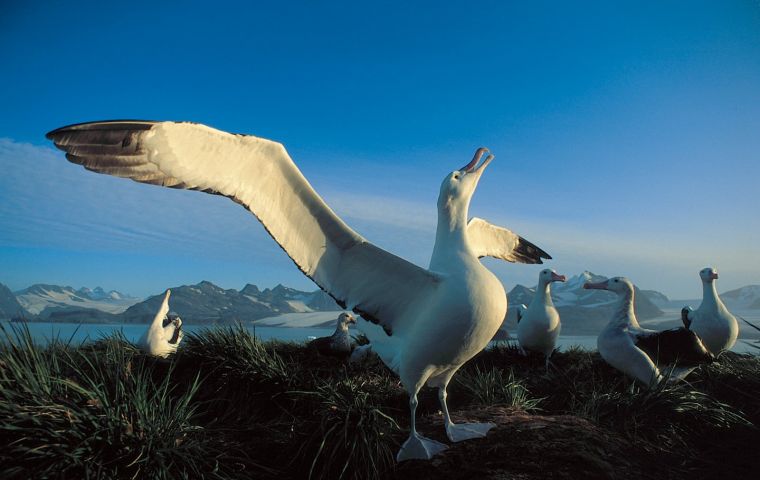MercoPress. South Atlantic News Agency
By-catch scientific research identifies danger areas for wandering albatrosses
 Adult albatrosses (Diomedea exulans) courting at Bird Island, South Georgia.
Adult albatrosses (Diomedea exulans) courting at Bird Island, South Georgia. Over half of wandering albatrosses breeding on Bird Island, South Georgia, in the sub-Antarctic, encounter fishing vessels when feeding, putting them at risk of being accidentally caught or killed in fishing gear, according to new research led by British Antarctic Survey and Birdlife International. The results will help conservation efforts for a species that is in decline.
In the study funded by the Darwin Plus Scheme and published this month (November 2022) in Biological Conservation, researchers tracked the movements of wandering albatrosses using radar-GPS devices to study their interactions with fishing vessels. By cross-referencing the birds’ movements with the locations of fishing vessels, they found that, of the 251 birds that were tracked, 55% went within 30km of a fishing vessel, and 43% within 5km. Birds traveling to the Patagonian Shelf break were particularly at risk of an interaction.
This study is one of the most comprehensive studies of by catch risk for any seabird species to date, and combines precise locations of fishing vessels from Global Fishing Watch, another collaborator of the study, with those of wandering albatrosses of different ages and breeding stages.
Richard Phillips, seabird ecologist at British Antarctic Survey, and co-author of the study says: “These detailed analyses provide us with a much more nuanced idea of where the risks are, allowing us to target our conservation efforts much more effectively. Now that we have identified the fleets that represent the greatest risk to albatrosses from South Georgia, it’s important that advocacy focuses on those particular fishing nations and the vessel operators.”
Seabird by-catch has already been reduced to negligible levels in the local fisheries around South Georgia. However, the paper highlights the urgent need to engage in other regions with fisheries managers, operators and crew from South Korea, UK, Chile, Portugal, Taiwan and Brazil, and ensure they implement best-practice measures.
By-catch is a risk for many seabirds, but albatrosses, which scavenge opportunistically, are particularly at risk. They are attracted by the bait, unwanted catch and discards, which mimic their natural food sources, but get caught on baited hooks set by long-liners, or collide with cables on trawlers. These interactions are the leading threat to most species of albatrosses and an estimated 100,000 albatrosses are killed each year by long-line fishing equipment alone.
Several bycatch mitigation measures have been developed in recent years. These include weighting hooks or lines more heavily so that bait quickly sinks beyond the reach of albatrosses, setting lines at night when many species are less active, and using colorful streamers that flap in the wind and discourage birds from approaching the vessel. However, albatrosses range up to 1,000 miles a day in search of food so they inevitably encounter fisheries that don’t use any mitigation measures.
Ana Carneiro, Marine Science Manager at BirdLife International and lead author of the paper, says: “We know that deaths or injuries of seabirds in fisheries can be avoided using simple but highly effective techniques. The problem is that there is no checking of compliance with those measures in many fisheries.”




Top Comments
Disclaimer & comment rulesCommenting for this story is now closed.
If you have a Facebook account, become a fan and comment on our Facebook Page!